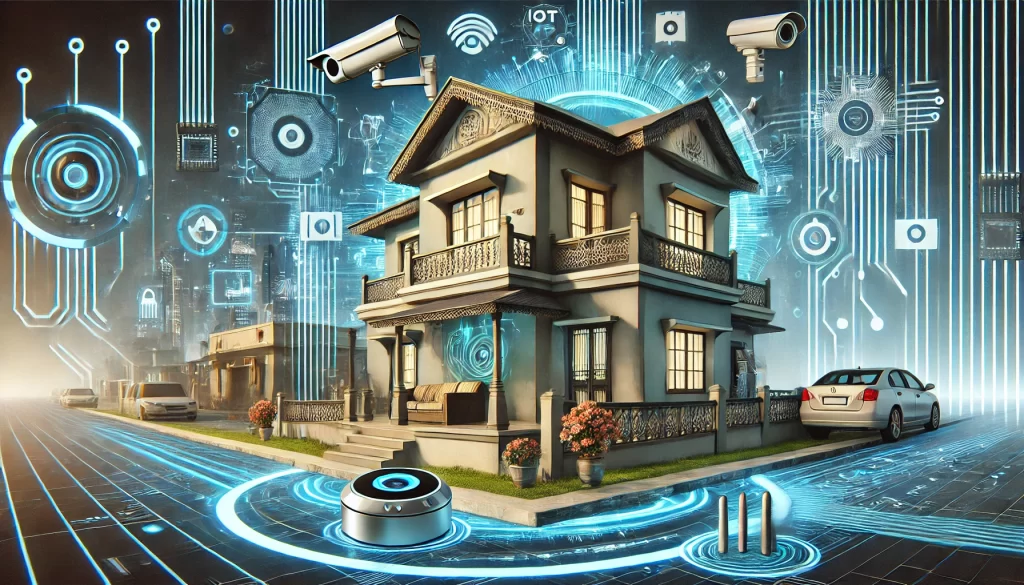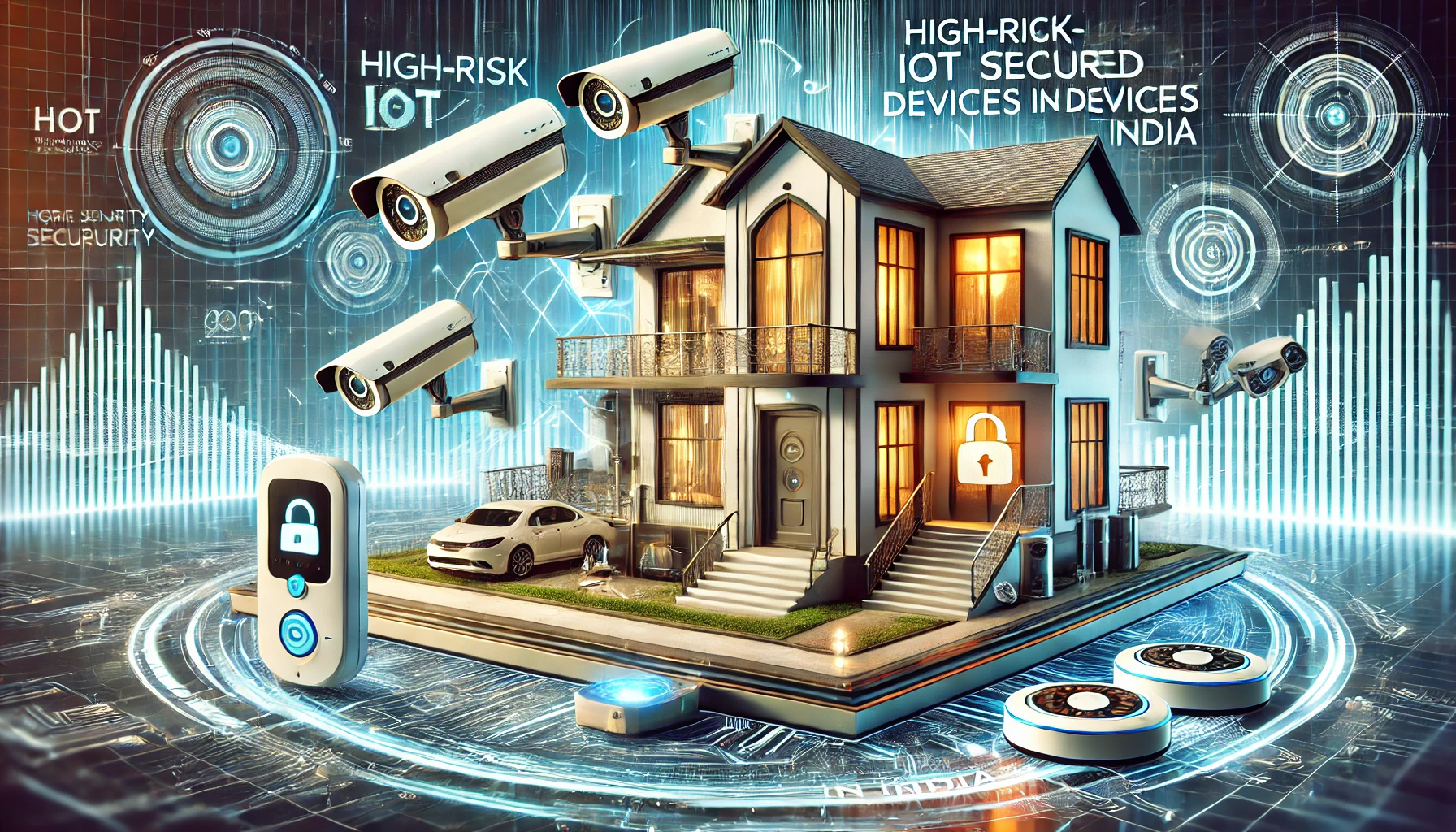AUTHOR : ISTELLA ISSO
Introduction
In recent years, the demand for home security devices in India has been on the rise, driven by increasing concerns over safety, crime rates, and urbanization. More advanced, Internet of Things (IoT)-based solutions, which offer higher convenience, efficiency, and real-time monitoring, are quickly replacing traditional security systems. However, these IoT-based home security devices come with their own set of challenges and risks, making them a high-risk area for both developers and consumers.
The Importance of Home Security in India

India, with its rapidly growing urban population and increasing rates of property crime, has created a need for smarter, more efficient security solutions. Homeowners are seeking advanced systems that not only offer physical security but also enhance peace of mind through real-time alerts, remote monitoring, and better control. This demand has fueled the adoption of IoT-based devices, which integrate advanced technologies to offer seamless and intelligent home security solutions.
Overview of IoT Technology in Home Security
IoT technology involves the interconnection of devices via the internet, allowing them to communicate and share data. IoT home security devices like smart cameras, IoT devices include locks, and sensors allow remote monitoring by relaying real-time data via the internet.
IoT-based security devices offer a range of benefits, including 24/7 surveillance, instant notifications, and the ability to control security features remotely. This integration makes home security more responsive and adaptive, catering to the dynamic needs of modern homes.
Challenges in Developing IoT-Based Home Security Devices
Despite their advantages, High Risk IoT-Based Home Security Devices In India IoT-based home security devices face several challenges:
- Technological Challenges: IoT devices rely on complex networks and software to function effectively. Issues related to compatibility, power consumption, and device longevity can complicate development.
- Privacy Concerns: Since IoT devices often require the collection and processing of sensitive data, privacy concerns arise. Hackers may attempt to access personal information, posing significant risks to users’ privacy.
- Connectivity Issues: While IoT devices rely on the internet, rural areas in India often lack the stable connectivity required for these systems to function optimally. Home security[1] The reliance on stable Wi-Fi connections can lead to security breaches if the system malfunctions or is disrupted.
Key Players in India’s IoT-Based Home Security Market
India’s IoT-based home security market is growing rapidly, with both local and global players making significant investments. Key players include:
- Local Startups: Many Indian startups have emerged as innovators in the IoT security space. Companies like Cure Metrix and Intello Tech are creating custom solutions tailored to the needs of Indian homes.
- Global tech giants like Google, Amazon, and Xiaomi are tapping into India’s IoT security market.
- The Indian government promotes IoT development through initiatives like Digital India. IoT Smart Home Security[2] These initiatives aim to foster innovation and increase the adoption of smart devices.
Types of IoT-Based Home Security Devices
Several types of IoT-based home security devices are gaining popularity in India, including:
- Smart cameras enable remote property monitoring with motion detection, night vision, and two-way audio.
- Smart Doorbells and Locks: Devices like Ring or August Smart Lock allow homeowners to control access to their homes remotely. High Risk IoT-Based Security[3] These devices often include video surveillance, allowing users to interact with visitors before granting access.
- Motion Sensors and Alarms: These sensors can detect movement and send real-time alerts to homeowners. Paired with alarms, they can act as a deterrent to burglars and ensure immediate action is taken.
Advantages of IoT-Based Home Security Devices

The primary benefits of IoT-based home security devices include:
- Homeowners get instant alerts on their devices for breaches or suspicious activity. This allows for quick intervention and minimizes the risk of property loss.
- Remote Access and Control: With IoT integration, security systems can be controlled remotely. Whether you’re at work or on vacation, you can arm or disarm the system, High-risk Environment[4] lock or unlock doors, or view camera footage at any time.
- Integration with Other Smart Home Devices: IoT-based security devices can easily integrate with other smart home systems, such as lighting, heating, and voice assistants. This provides a cohesive and efficient smart home experience.
The Role of Artificial Intelligence in IoT Home Security
AI has revolutionized IoT-based home security devices by enabling features such as facial recognition, behavioral analysis, and advanced threat detection. high-risk dictionary[5] AI algorithms can analyze data from cameras and sensors, detect unusual activity patterns, and alert homeowners of potential threats. These advancements increase the overall effectiveness and reliability of home security systems.
Security Risks and Vulnerabilities in IoT Home Devices
While IoT devices offer convenience, they also present significant security risks:
- Cybersecurity Risks: Hackers can target IoT devices to gain unauthorized access to homes or collect sensitive data. Weak passwords, unsecured networks, and outdated software make devices vulnerable to attacks.
- Potential System Failures: IoT systems are dependent on both software and hardware. Any failure, whether from device malfunctions or power outages, can compromise security and leave homes unprotected.
- IoT devices risk leaking personal data like video footage or access logs.
Government Regulations and Standards for IoT Security
India has been developing regulatory frameworks to address IoT security and privacy concerns. The government is working to implement data protection laws and cybersecurity standards to ensure that manufacturers adhere to best practices in developing secure IoT devices.
Globally, standards such as the IoT Cybersecurity Improvement Act in the US and ISO/IEC 27001 provide guidelines for securing IoT devices. India’s alignment with these global standards will help ensure the security and safety of IoT-based devices in the future.
Consumer Awareness and Adoption of IoT Security Devices in India
While the adoption of IoT devices in India is steadily growing, there remains a significant gap in consumer awareness. Many homeowners are still unaware of the potential risks associated with IoT devices. Educating consumers about security features, installation guidelines, and potential threats is essential for increasing adoption rates and ensuring the safe use of IoT technology in homes.

Case Studies of Successful IoT-Based Home Security Solutions in India
Several IoT-based home security solutions have seen success in India. Companies like Nest and Mi have developed affordable smart security products tailored to the Indian market. These solutions have provided an easy entry point for homeowners looking to adopt smart security, making IoT security more accessible to the masses.
The Future of IoT-Based Home Security in India
The future of IoT-based home security in India looks promising. With advancements in AI, machine learning, and 5G connectivity, IoT security devices will become even smarter, more reliable, and efficient. As India’s digital infrastructure improves, IoT-based security systems will likely become a staple in every home.
Conclusion
IoT-based home security devices are a promising solution to the rising demand for enhanced home security in India. While they offer numerous benefits, including real-time monitoring, remote access, and integration with smart home devices, they also come with risks such as cybersecurity threats and privacy concerns. With government support, technological advancements, and increased consumer awareness, IoT-based home security systems are poised to become a vital part of India’s smart home ecosystem.
FAQs
- What makes IoT-based home security devices high-risk? These devices rely on internet connectivity, which exposes them to cybersecurity risks, potential system failures, and privacy concerns.
- How does AI enhance IoT home security? AI enables advanced threat detection, facial recognition, and behavioral analysis, improving the accuracy and responsiveness of IoT security systems.
- Are IoT-based security devices secure? While IoT devices offer convenience, they can be vulnerable to hacking if not properly secured. It’s essential to follow best practices like using strong passwords and keeping software up to date.
- Which IoT-based security devices are popular in India? Popular devices include smart cameras, smart locks, doorbells, and motion sensors from brands like Xiaomi, Ring, and Nest.
- What challenges are faced by IoT home security systems in India? Major challenges include cybersecurity risks, privacy concerns, connectivity issues in rural areas, and a lack of consumer awareness about security practices.

